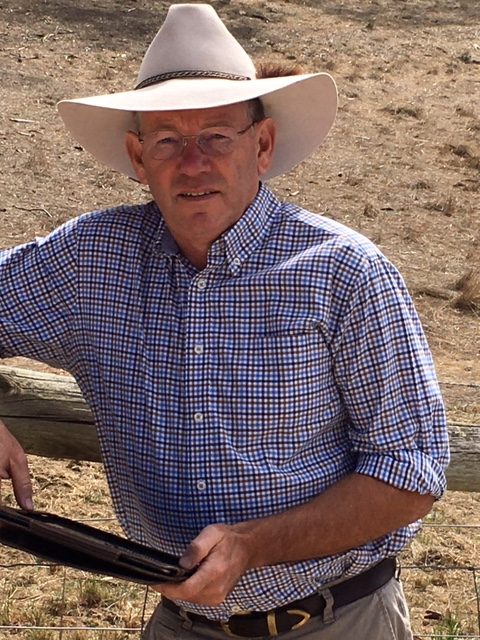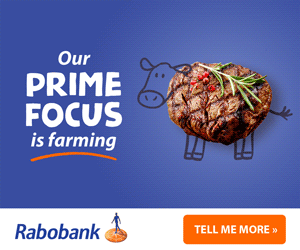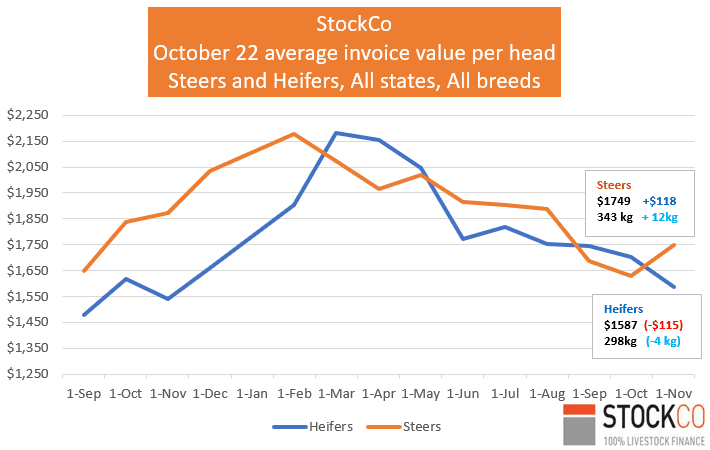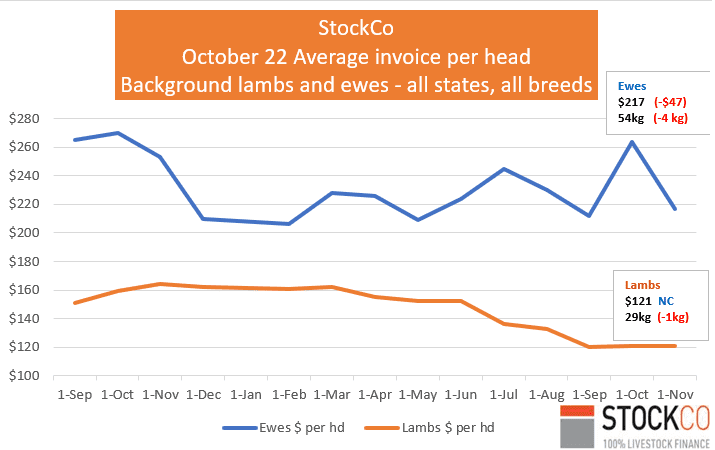Chris Howie: We’re starting to see store steer prices run again

Quick comparison against October 2020
- Wet with grass – same
- Lambs hooks $7.20 to $7.60, Sale yard price around $8.00 – same
- Quality merino ewes hovering between $270 & $350 – same
- Best heavy cows were $3.20 now $4.40 – up a dollar
- Quality cows / heifers with calf at foot $3000 to $4000 – same
- Dairy heifers were $1700 to $1900. NZ banned live export now $2650
- Wool indicator 2020 1106 cents – 2022 1323 cents – better
- Indo live ex steer $3.60 now $5.20
- Diesel 2020 national average 2020 $1.08. Today – (Swear word) ridiculous
Staff shortages and visa access. Conversation starter about getting backpackers into the bush again. It will need to be driven by industry bodies because government is too slow and individual business is not accountable to deliver satisfactory working arrangements to make this function.
Simple idea
- Requires the candidate to lodge the cost of their airfare / travel into an Industry trust account.
- Industry / employer pay for the airfare with the understanding if the individual remains in their employment for a minimum of 6 months they will get the initial amount refunded plus $2500, or whatever is decided. This is paid to industry by the employer for disbursement in advance.
The backpacker still receives normal wage for work and has an incentive to become part of your team.
Cattle
I am not an economist or an analyst so make your own mind up on my following comments.
This year we saw COVID in January block the flow of lamb processing and numbers accelerated by the FMD fear in autumn and winter. One question was “where did they all come from?” Looking back it became evident many of the lambs had previously been purchased by processors as light air freight lambs and removed from the system. COVID saw the trade stop with no planes flying that saw them feed back into the grass system – extra numbers.
 Jumping forward to cattle. We know many northern cattle went on grass in 20 & 21 that normally go to Indonesia or Vietnam. Most of these grassy’s would have been targeted for sale into the feed lot sector.
Jumping forward to cattle. We know many northern cattle went on grass in 20 & 21 that normally go to Indonesia or Vietnam. Most of these grassy’s would have been targeted for sale into the feed lot sector.
After several conversations at Beef Ex it became apparent many feeder cattle in SW Queensland and NSW have blown over feedlot entry weight s of 520kg with the continued grass season and inability to muster because of water. These “overweights” have been turned back out to return as heavy cattle, much the same as occurred in 2016.
My considered opinion is we will see a significant run of heavy grass cattle appear in the North from March 2023. Many originally destined for grain feeding will now start to soak up available grass fed processing space in big numbers.
Demand for Australian beef remains strong but our pinch point (like lambs) is the ability to process the numbers. Now we have 3 moving parts, Demand – strong, Supply – very good, Processing ability – restricted. I suggest you start thinking about your sale program and booking processor space soon.
Beef Ex in Brisbane was an excellent event and congratulations to ALFA on how well run it was. A highlight for many was a presentation from past Australia treasurer Peter Costello on Global economics. This was outstanding and laced with great insight and humour. Beef Ex market report
Store prices. We are starting to see the store steer prices run again on the back of available feed not the contract pricing available. Heifers during October were under the radar however Dubbo indicates they are starting to draw attention as an option now.

Feeders – Many lot feeders are looking at the cost dynamics and a few things became evident in all conversations at Beef Ex.
- Availability of staff
- Tightening of demand and price on cattle over 450kg
- Viability of short-term feeding for domestic supply being questioned at current pricing
- Increase in numbers of Wagyu in feedlots – long fed, less staff needed.
- Performance data on cattle – only feed those that perform (well weaned cattle are part of this)
Feeder numbers are really starting to increase and I expect to see feeder prices fall away quite rapidly leading into Xmas.
Andrew Peadon, Barlow & Peadon Shute Bell, Dubbo gave me a report on last Fridays Dubbo female sale which was pushed back a week because of the big rain. About 3000 came to hand across all agents with a widespread gallery of buyers including local, Mudgee, Orange, Hunter, Gunnedah and Tamworth with an A+ interface operating also. Quality Angus cow and calf units with a bit of a story made $4100 – $4200 with most British bred in the mid $3000’s. Good run of quality Bos x cows and calves 7 – 9 years made $3100 – $3200. PTIC cows with style around $3000 and a small number of PTIC heifers between $2500 – $2600. Unjoined heifers ranged from $1700’s to $2200 for some well bred Charolais x girls.
Tim Drum, Director for Riverina Livestock Agencies at Wagga commented that the cattle job has been outstanding especially for cows and heavy steers. Numbers at the Wagga weekly sale have still been smaller than normal due to water and reduced numbers since the drought. Both of us agree we may see the feeder job start to move down over the next few weeks as access to paddocks opens up.
Michael Spencer and Nick Hall Adcock Partners, Property and Livestock said the floods at Moree heading towards Walgett are moving very slowly and creating a significant issue for crop and livestock. Nick said the New England is still wearing afternoon storms that are keeping the gully’s clean with some large falls. I asked what the Darwin live ex rate is doing, and Michael said it is hovering around $5.10 – $5.20 at this time with some large tender deliveries completed a little higher.
Weaner selling season is upon us with the first of the special sales about to start in SA and WA. Over the past 2 months we have seen last year’s steer calves being sold and margins have been tight with the odd negative return. If you are a seller prepare your calves to get the best returns this year – weaning will make a difference to the price received. Especially if you are targeting the feedlots.
Dairy
Speaking to Rob French, National Dairy manager for Elders. Floods have impacted many dairies with fodder and tanker access becoming an issue. However, the industry overall is in an excellent position. Rob said “Change over value for choppers and cows fresh in milk is only a couple of hundred dollars apart. Good commercial cows in milk are ranging from $3200 to $3400 and Jerseys to $4000. Classy stud cows averaged $5980 this month and export dairy heifers 200kg plus are bringing $2650 aimed at China.”
Sheep.
The numbers continue to get pushed together because of weather. Soon there will be some sun and a clear run at drafting lambs. This is when prices are going to struggle under a significant volume of trade lambs. The signs are heavy lamb numbers are short at this time and it is being reflected in improved pricing. I stick by my advice for the last 2 months. If you can get at your lambs sell the lead heavies sooner than later.
Store sheep and lambs. Plenty of store lambs at present with prices flat tracking. Shorn store lambs are now drawing attention and seem to be rewarding those that have been able to shear. Light merino ewes seem to be in demand over the last few days of October – Processors and fatteners. Maybe an opportunity on heavy ewes to trade into next year at current values.

Rodney Dix, Director of Spence Dix and Co at the Keith breeders sale reported best merinos topped at $372 with the majority of the 1.5year old’s making $290 – $$350 and the older ewes in excellent condition $170 – $278. Widespread support from SA and Vic with many repeat buyers.
Mutton prices are still very flat with the lamb numbers available keeping the pressure on space. Paul Kilby, Kilby Stock and Station, Barossa and West Coast said “processors handling heavy mutton range from $4.20 to $4.60 drs weight although freight evens it up pretty well. One processor has $5 – $5.20 on light mutton under 24kg drs with a significant penalty over 24kg. Waiting times for delivery are about 3 – 4 weeks”
Andrew Peadon, Barlow & Peadon Shute Bell, Dubbo said lamb numbers had been affected over the past 2 weeks with rain and yardings of only 14 / 15,000. However with roads drying numbers are rising quickly with yarding expected over 20000 in the near future.
Tim Drum, Director Riverina Livestock Agencies at Wagga. “the last 2 weeks yarding’s have been large although 50% of the lambs are in the store category. Many are rain affected and have not done starting to run to wool. Merino lambs continue to be good buying at $85 – $110, Store XB’s are $120 – $140 with heavier feeder lambs 42 – 45kg making $140 – $160. Heavy export lambs are in short supply with only 10 – 20% of the finished lambs in this category. Heavy hoggets seem to be reaping the reward of this shortage with a significant lift last week. Plenty of trade weights are well supported although the slippery, washed-out trades are being picked through. Older lambs are nearly done with only 1 lane being offered.”
Spoke to Alex Collins, Director McKean McGregor in Bendigo Monday and he said the lamb sale continued in much the same vein as Wagga’s report with heavies well sought and perhaps $4 – $8 cheaper after a soft start. Trade suckers held ok but slippery trade suckers going to wool fluctuated to be $20 easier.
1st Cross sales. Corowa NSW 1st x sale achieved a top of $412 for 380 to repeat buyers showing demand is still strong. Alex Collins, McKean McGregor let me know all agents will yard 30 – 31,000 1st cross ewes at Bendigo this Friday the 4th. Quality will be good although some of the lambs may be a bit lighter than last year with the long winter. For the first time Bendigo will split this sale with another run on the 2nd of December allowing rain effected ewes to freshen up under a bit of sun.
Richard Harvie, Director PPH&S Naracoorte advised the dates and numbers for the Naracoorte sales. 1.5 year sale is on November 10th. Richard indicated numbers will be around 14 / 15,000 and down on last year. “With the rates being paid for ewe lambs last year many did not think there was sufficient margin to trade on” he said. The ewe lamb sale follows on November 17th with 30,000. Richard expects the tops will be very good but considering the season the middle run of lambs may be a bit behind on weight this year.
Flys – Anyone treating for fly make sure you look at the WHP and ESI time frames. The last big fly season saw some lamb trades impacted by an extended ESI which means you cannot sell the lambs for slaughter
“Good god is that the sun?” and Australia is Irish green. We have seen weight gains falling in some areas as happened in 2020 yet there is abundant feed, how is this possible? Rob Inglis, Elders Livestock production manager explained that pasture sugars are now locked in the indigestible fibre. Lambs and young cattle cannot physically fit enough grass into their stomach. This limits the amount of energy that can be absorbed so limiting weight gain. Providing loose lick or supplementing grain will help convert this bulky indigestible feed and reactivate weight gain. It is worthwhile having a chat to your local advisors to best utilise feed and continue to create positive weight gains.
Training. The Wodonga TAFE Agency and Supply Chain training is back in full swing with 45 participants at various stages currently. The next workshop is planned for the 20th February 2023 with 8 new starters already registered. This course now allows full Certificate 4 in Agriculture, Auctions Plus training, the option of workshop only and is open to any wishing to upskill or start a career in the agricultural industry. Simone Dand is the contact 0455 240 307
Big changes at StockCo with new parent company Heartland in the process of securing a bank in Australia. This creates real opportunity for seasonal and breeder livestock funding for producers, Stock Agencies and Service providers. It will dry out eventually and having your finance in place ready to capture the opportunity is simple with no application or line fees.
School leaver job interview tips: Having conducted 100’s of interviews here are a couple of tips when applying for your new career.
- Do some homework on your potential employer – what does their business do?
- Understand what you will be required to do and the hours required. Not many new starters get a managers wage day one – even if you have finished Uni.
- Dress for the interview as though you want the job – hair done, ironed shirt, polished boots, minimal makeup
- Tell the interviewer how you are going to help their business and what your goal is – if you don’t have a goal one no one can help you get there.
Opportunities
- If they (anything) are ready to sell take the money now
- Old ewes / wethers on excess feed – bring back next year or join
- Straight lines of heifers – attractive cattle sell well
- Think about custom feeding a pen of your weaners in 2023
- Shear your lambs
- Set your kids up to succeed
- Stay positive – Australia is still a great place to live






